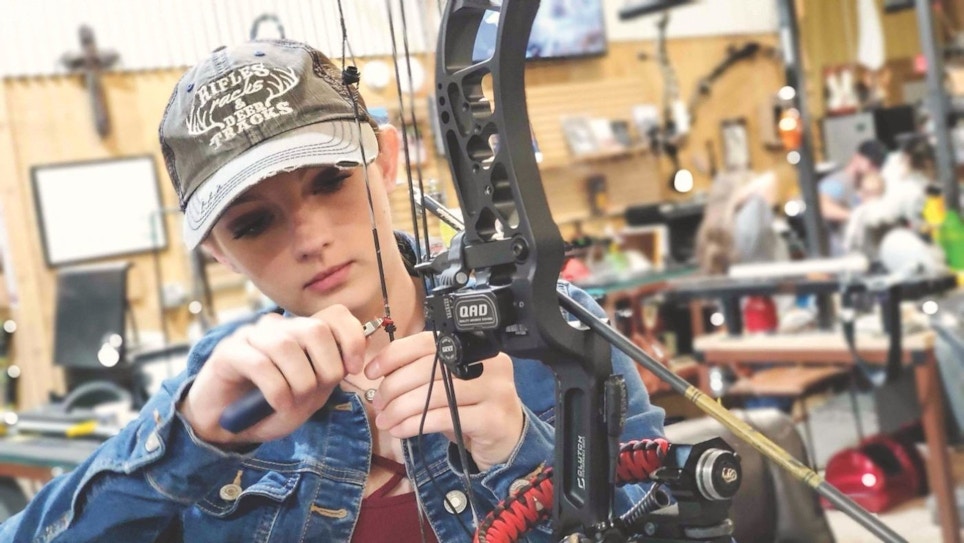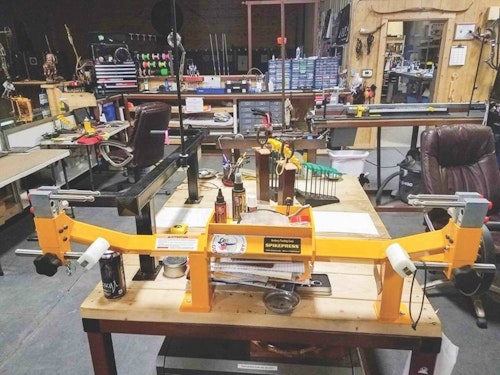It’s been a minute or two since I worked behind the service counter of an archery department or shop. Still, I have never forgotten the benefits of high-quality service for archers and retailers alike. Well before I worked as an archery technician, I was an avid archer and bowhunter. Sure, I shot ancillary local and regional competitions; league shooting is rooted in my most rapid stick-and-string growth. While we were scored on handicaps, I also shot next to new and veteran league shooters, as well as national level competitors. As intimate as many league shoots are, I grew the most at such events because of the mentorship I received from those guys — they were always happy to share their passion and knowledge. As a customer returning weekly to compete, I also built valuable relationships with onsite technicians.
Truth be told, the combination of sharing similar passions, being welcomed into the ranks and mentorship I received from them, had a lot to do with my decision to get behind a counter and, moreover, how to engage those fine folks who bellied up to it. I may not have followed every corporate rule, but what I had mimicked from mentors and established as a technician certainly worked to the benefit of both the big box store where I began my service work and the pro shop where I finished. Worth mentioning here, while the differences in big box and pro shop landscapes were pretty significant, my work, my attitude and my approach to service never changed. This consistency was foundational to not just maintaining a service center, but also growing it. Here are a few foundations to consider.
1. Hire the Right People
A team is only as good as its weakest link. Considering pro shop services as a business (within a business), technicians must be trustworthy, knowledgeable and experienced. I would say big box retailers have been notorious for trusting technicians who lack knowledge or experience, or both. Many years ago, I saw this firsthand, a nearby retailer put a gentleman to work as an archery technician who had never fired a bow. For the retailer, this was an inherently dangerous move that opened them up to liability. The technician and the customers he served were put in exceedingly dangerous situations. Fortunately, I’m not aware of any injuries, but news of shoddy work, some again, downright dangerous, traveled fast. Scores of frequent service customers left and never returned — electing to pay more at a nearby shop — and ultimately, the technician was terminated, sad, because he was indeed set up to fail. I can’t imagine how much the loss in customer retention, loss in new customers and an embarrassing reputation cost them. The retailer shut its doors years ago.
2. Foster Welcoming and Encouraging Attitudes
Oddly enough, while most industry professionals, service technicians and counter guys included, were welcomed into our outdoor heritage by great people, we have amassed a reputation of NOT being so great. Even as an archery technician and seasoned bowhunter myself, with nearly 20 years of string bending under my belt, I’m still the recipient of occasional cold stares and condescending comments when I walk into a shop for the first time. If this is you? KNOCK IT OFF! Not only is this type of attitude a poor representation of our heritage, but it also inhibits sales, kills customer retention, and like the first issue, builds a reputation you don’t want. Of course, if you or an employee are acting like condescending fools, re-read above. You were likely welcomed into archery and bowhunting with open arms, even tried-and-true mentorship. Pay it forward! Welcoming customers and choosing to project a positive attitude not only warm folks up to our heritage, but it also makes them come back to purchase your services and wares.
3. Include Space, Technology, Training and Growth
Service centers require space, and the more you diversify and grow, the more you need. Advances in technology and expanding the range of products techs can service may also require more room — maybe adding crossbows to your mix means setting up a dedicated press to accommodate them. Adding service products also can require expanded space. If you’re planning to build your own strings and cables, it takes real estate and a bench to build, twist and stretch them. Need a place to paper-tune bows? If you want to paper-tune away from range functions, you need service center space. As limbs become shorter, limb pockets become larger, past-parallel limb design (and stress) becomes more significant, and, as accessories become more complicated to set up, adjust and fine-tune, the range of special presses, specialized press components, jigs and tools do, too. If you expect to be a one-stop-shop service center, you have to invest in those people and products capable of handling those jobs, including technician training.
Most bow manufacturers offer technician certification training, and they are often worth attending. Those who don’t attend don’t get a free pass, but some also can’t afford such training events. This doesn’t excuse technicians for falling behind archery’s technological curve. Most understand they must do their homework at home to stay on top of advancing technology if they want to continue to compete with other shops. If you’re an employer of technicians, the most ethical and safest way to ensure your techs and your customers receive world-class service is to invest in the training and equipment needed to keep your shop on the industry’s leading edge. Experienced, knowledgeable and trained technicians with the right equipment and the right training are an excellent recipe for service success.
4. Offer for FREE!
Offering freebies is as old a strategy as any in the marketing world. The old adage, “Don’t step over dollars to pick up dimes” applies here. Sure, you take a minuscule hit when you offer a free service. Still, you often pick up great customers and foster healthy, loyal relationships as a result. So, what kind of freebies pay dividends on the backside? Inspections and conditional services, including lessons and range access.
Free inspections foster trust between technicians and customers and also opens the door for paid services. When technicians demonstrate goodwill and trust is established, relationships are forged. As a result, customers are more open to servicing, advice and product sales. Of course, the side benefit is that these patrons often come back, become loyal customers and endorse your business to others.
Conditional freebies mean services are free with purchases. They can even include opt-in subscriptions to your email newsletters and future discount offers. Some excellent conditional services include free bow set up (including accessory installation and tuning) with the purchase of a bow, free lessons and/or range access (for a set time) for bow purchasers and free installation of accessories with a stated minimum purchase amount — this eliminates the potential for services like serving in a peep sight for someone who spent next to nothing on the product. Think of creative service offerings you can extend to your customers. It’s always okay to step over dimes to pick up dollars.
5. Discount Service Deals
Who doesn’t like saving money? If your customers didn’t opt-in to your email newsletters and offers, presenting coupons for services and products may be a great way to bulk up your subscriber base and population of returning customers. Much like those oil change coupons you get in your mailbox, you’re likely to boost your off-season archery service sales by offering “25% off your next bow tune-up” or “10% off your next string and cable replacement.” Sure, countertop signs and social media posts also work great to get the message out — if customers are looking — but reaching out to archers with your good news is never a bad idea. Coupons, points or store bucks from purchases that can be applied to further discount services also are a great idea. Not only do these programs incentivize product purchases, but they also incentivize service treatments. Sure, consumers may get ancillary discounts, but they frequent your store and spend more often. Discount programs should also get your customers registered with your service department… and subscribed to your email communications.
6. Get Social
If you’re not on social media, get there. Facebook and Instagram are free vehicles of marketing. Create business pages or profiles and use both platforms to share expanded service offerings and deals. Many company’s also use social media platforms for contests, giveaways and other notable business and marketing campaigns. In addition, profiles can be used to share success stories, engaging archery- or bowhunting-themed content, news, shop events like league shoots, competitions and training events. An essential aspect of utilizing social media is to focus on local outreach. The balance can be delicate since social media doesn’t have borders, per se, but catering to connections based regionally, who can actually become customers, can be beneficial. National outreach, unless you have a national or online presence, can detract from the regional focus you need to maintain. Another great way to reach out to people who can be actually become shop and service clients is by advertising in local media. Consider building relationships with local media personalities and advertising professionals from newspapers, radio and television shows, podcasts and other local influencers. Building media relationships helps ensure exposure for your overall retail establishment, service center offerings and notable company news. The key here is presence, presence, presence.
7. Hold Events
For many archers and bowhunters, their connections to archery and hunting begin (and sometimes end) with their pro shops. One of the character attributes I love most about my home shop and range, Fort Grard Archery and Guns, in Weatherford, Texas, is the atmosphere. While Fort Grard boasts 27 acres of traditional, 3-D, motion and long-range target shooting outside, it’s what’s inside the doors that keeps me coming back — community. Sure, Randy Grard is as passionate a business owner and brilliant an archery technician as anyone I’ve ever met, but what he’s created in relationship building while slinging sticks is something worth emulating if you can — it’s quite extraordinary.
Some shops may be able to create an experience like Randy’s, while others may not. Either way, archery, including bowhunting, is a lifestyle. Virtually every customer crossing your threshold either has an interest in our lifestyle that should be nurtured or already lives it. The good news here is that promoting our lifestyle, and the relationships that are often forged as a result of a gathering is easy — schedule and administer fun shop shooting events. It’s often said, “If you want to become a great archer, shoot competition.” League shoots fit this bill nicely and get people in your door. League shooters also often build relationships with technicians by having their equipment enhance or maintained to improve their competitiveness. Fun and league shoots can include food, door prizes, competition awards and mentorship opportunities from seasoned veteran shooters.
8. Warranty Your Work
If your service is excellent, back your play. Market it. Share the good news! Let people know your service is so exceptional, you stand behind the work and the right people who make your behind-the-counter magic happen. Nothing incentivizes a consumer to give your service department business like the peace-of-mind an archer or bowhunter gets by knowing you’ll be there to make things right if something goes awry. Even before there is trust, a warranty lays the groundwork for entering into a good-faith relationship. Build trust the old-fashioned way — earn it with integrity and reliability.
A side benefit to warrantying work is sales, even at higher price points. Manufacturers have known for years that consumers pay more for service than for product. This is to say, people are willing to pay more for products back by service from a company they believe won’t pack up and run if things go wrong. Equally as important is reputation. Garnering a reputation as a company more than willing to back its services gets people talking about and endorsing your business. Word-of-mouth is a powerful, powerful thing, but it also goes both ways. To such an end, every customer then is an author, a storyteller. What story about your business — about your services — do you want people to share? Endeavor to write their stories for them.
9. Track Your Results
Marketing might seem like nothing more than throwing ideas, strategies and campaigns against a wall and hoping they stick. Still, there is actually some methodology behind the marketing madness. Tracking — engagements, responses, conversions, returns on investments, etc. — is a critical component of effective marketing. Whether you work through suggestions presented here or not, the importance of determining which strategies and campaigns work better equips you to make sound marketing decisions moving forward. If it works, it works. If it doesn’t, it doesn’t. Don’t waste valuable time, energy and resources chasing down programs that don’t deliver stable returns on your investments. Shift gears and keep driving.









